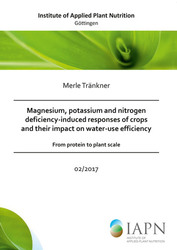| Fachbereiche | |
|---|---|
| Buchreihen (96) |
1378
|
| Nachhaltigkeit |
3
|
| Gesundheitswesen |
1
|
| Geisteswissenschaften |
2365
|
| Naturwissenschaften |
5406
|
| Mathematik | 229 |
| Informatik | 319 |
| Physik | 980 |
| Chemie | 1363 |
| Geowissenschaften | 131 |
| Humanmedizin | 243 |
| Zahn-, Mund- und Kieferheilkunde | 10 |
| Veterinärmedizin | 108 |
| Pharmazie | 147 |
| Biologie | 835 |
| Biochemie, Molekularbiologie, Gentechnologie | 121 |
| Biophysik | 25 |
| Ernährungs- und Haushaltswissenschaften | 45 |
| Land- und Agrarwissenschaften | 1004 |
| Forstwissenschaften | 201 |
| Gartenbauwissenschaft | 20 |
| Umweltforschung, Ökologie und Landespflege | 148 |
| Ingenieurwissenschaften |
1793
|
| Allgemein |
98
|
|
Leitlinien Unfallchirurgie
5. Auflage bestellen |
|
Erweiterte Suche
Magnesium, potassium and nitrogen deficiency-induced responses of crops and their impact on water-use efficiency - from protein to plant scale - (Band 2)
Merle Tränkner (Autor)Vorschau
Inhaltsverzeichnis, PDF (41 KB)
Leseprobe, PDF (100 KB)
The world’s population reached 7.3 billion in 2015 and according to the United Nations, the world’s population will continue to grow by 1.18 % per year, projected to reach 8.5 billion in 2030 and 9.7 billion in 2050 (United Nations, 2015). Consequently, global demand for food is steadily rising and exerts a pressure on the need for more efficient crop production. However, efficient crop production is hampered by biotic and abiotic stress factors, such as drought. Drought poses the most important limitation to crop productivity in the world (Lauer et al. 2012) and increases in the frequency and intensity of drought events are predicted (Pachauri and Meyer 2014).
| ISBN-13 (Printausgabe) | 9783736995369 |
| ISBN-13 (E-Book) | 9783736985360 |
| Buchendformat | A5 |
| Sprache | Englisch |
| Seitenanzahl | 134 |
| Auflage | 1. |
| Buchreihe | Institute of Applied Plant Nutrition - Göttingen |
| Band | 2 |
| Erscheinungsort | Göttingen |
| Promotionsort | Göttingen |
| Erscheinungsdatum | 12.05.2017 |
| Allgemeine Einordnung | Dissertation |
| Fachbereiche |
Land- und Agrarwissenschaften
Pflanzenproduktion |
| Schlagwörter | Magnesium, potassium and nitrogen, deficiency-induced |








